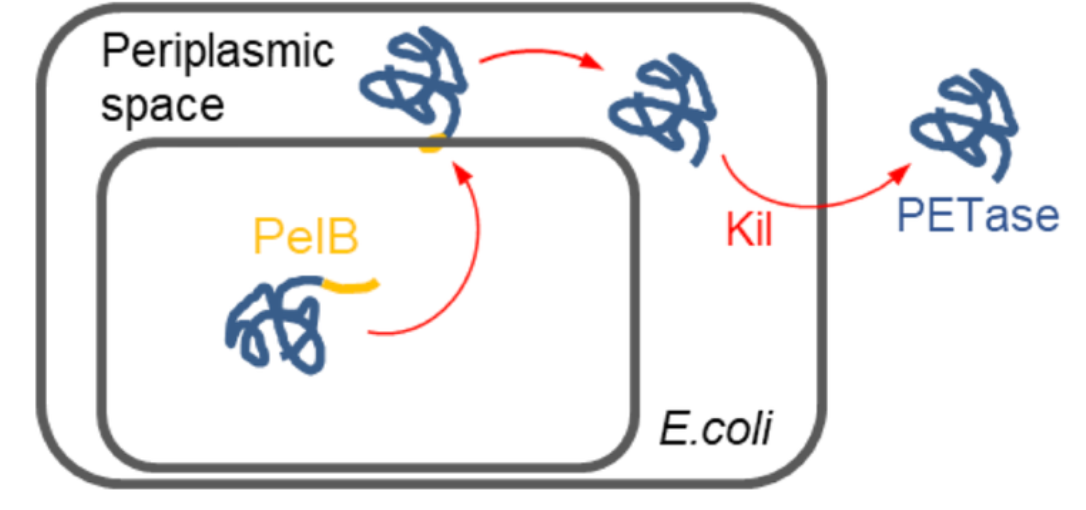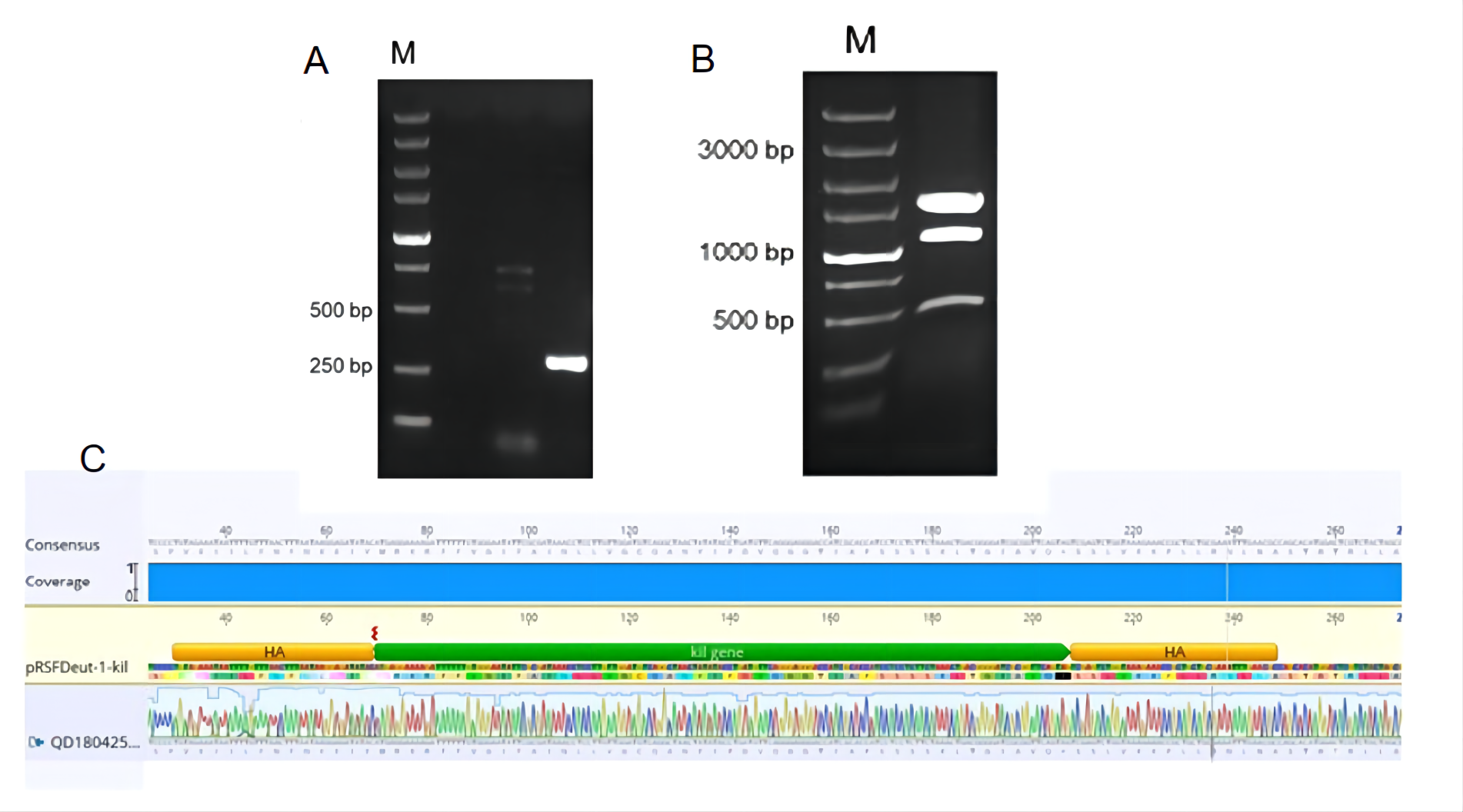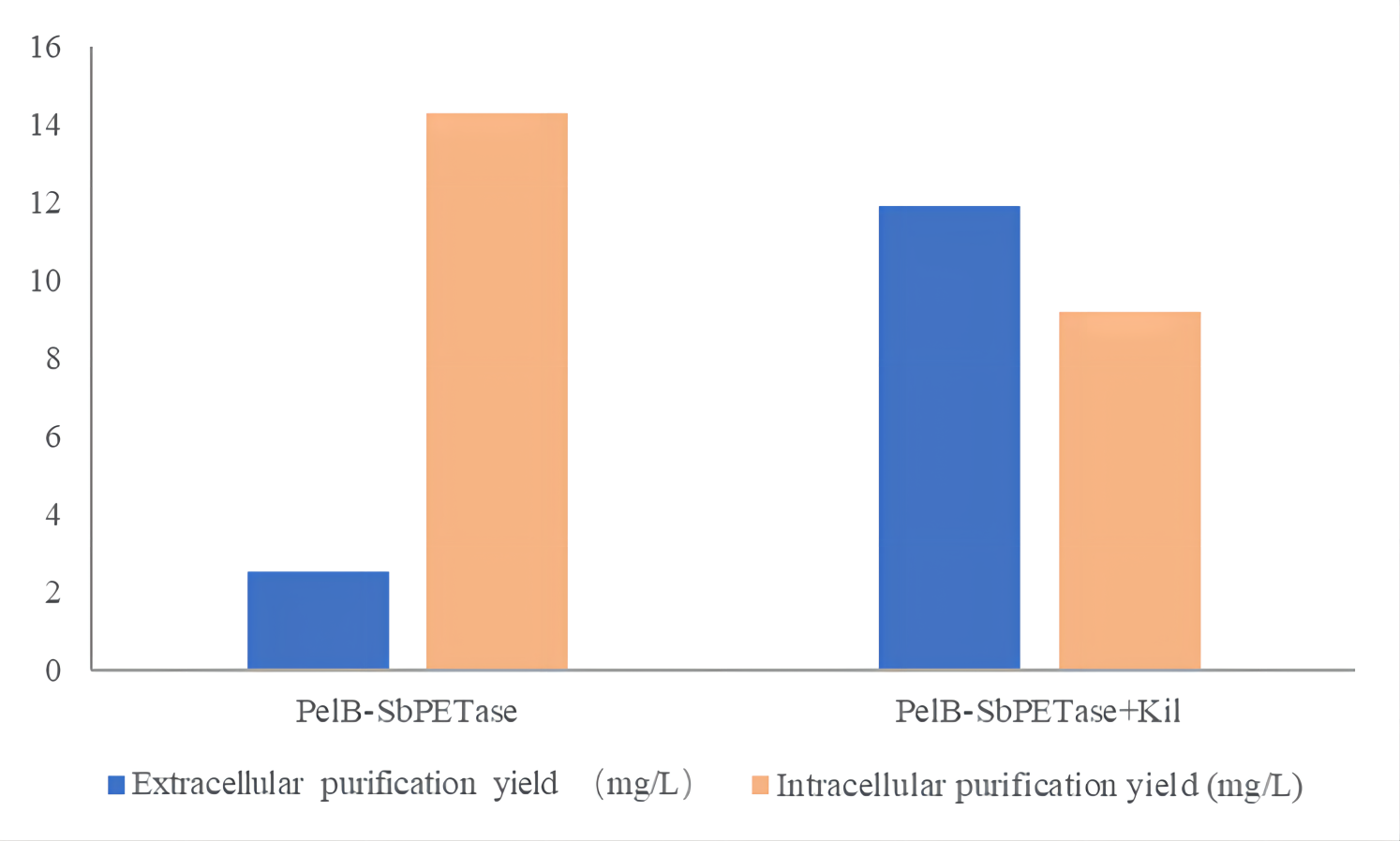Part:BBa_K2013021
pelB-5D
This part contains a special signal peptide that Enhance the secretion of secreted proteins. pelB is a signal peptide promoting protein secretion, through literatures we learn that adding 5 aspartate sequence behind it can enhance its function. Therefore,this part(pelB-5D) is a improvement of existing of BBa_J32015(pelB)
Sequence and Features
- 10COMPATIBLE WITH RFC[10]
- 12COMPATIBLE WITH RFC[12]
- 21COMPATIBLE WITH RFC[21]
- 23COMPATIBLE WITH RFC[23]
- 25INCOMPATIBLE WITH RFC[25]Illegal NgoMIV site found at 54
- 1000COMPATIBLE WITH RFC[1000]
Experimental Validation
This part is validated through five ways: amplification, PCR, Enzyme cutting, Sequence and SDS-PAGE.
Amplification
Enzyme:KOD
Primer-F:5′- GAATTCGCGGCCGCTTCTAGATGAAGTACCTGCTGCCGACCG -3′
Primer-R:5′-CCGCTACTAGTAGTCATCGTCATCGTCCGCCAT-3′
Results

PCR
Enzyme:Taq
Primer-F:5′-CCACCTGACGTCTAAGAAAC-3′
Primer-R:5′-GTATTACCGCCTTTGAGTGA-3′
Results

Double digestion
After the assembly ,the plasmid was transferred into the Competent E. coli top10. After culturing overnight in LB,we minipreped the plasmid for double digestion .The first cutting procedure was performed with EcoRI and EcoRV restriction endonuclease. The second cutting procedure was performed with PstI and NcoI restriction endonuclease.The plasmid was cutted in a 25μL system at 37 ℃ for 1 hours. The Electrophoresis was performed on a 1% Agarose glu
Results

SDS-PAGE
In order to verify the function of pelB-5D, we constructed piGEM2016-001, piGEM2016-002,piGEM2016-module01* and piGEM2016-module01. piGEM2016-001 and piGEM2016-002 are the expression vectors containing pelB-5D and PETase, the only difference between them is the immanent signal peptide of PETase with piGEM2016-002 was removed.piGEM2016-module01 and piGEM2016-module01* is a vector containing PETase and MHETase, the difference between them is that pelB-5D is added in the front of piGEM2016-module01s'MHETase. SDS-PAGE results of piGEM2016-001 and piGEM2016-002 show that the pelB-5D is working.Further more,SDS-PAGE result of piGEM2016-module01 is obviously better than that of piGEM2016-module01*. In short,All results show that pelB-5D can significantly enhance the secretion of extracellular protein.

Characterization by 2022 Beijing_United
Profile
Name: pRSFDeut-1-kil
Base Pairs: 3623 bp
Origin: Escherichia coli, synthtic
Properties: kil is coned into pRSFDeut to improve the yield of extracellular SbPETase protein
Usage and Biology
SbPETase is a novel enzyme for Poly (ethylene terephthalate) (PET) hydrolysis. PET is one of the most commonly used plastics worldwide and its accumulation in the environment is a global problem. PETase has been reported to exhibit higher hydrolytic activity and specificity for PET than other enzymes at ambient temperature [1]. Enzymatic degradation of PET using PETase provides an attractive approach for plastic degradation and recycling [2]. Various enzymes showing PET depolymerization activity have been identified and investigated in recent years, such as cutinases, PETase, MHETase, lipases, and esterases[3-8]. SbPETase can degrade PET into small fragments, then transport the degraded products for further "digestion", and finally convert them into two relatively simple organic compounds, ethylene glycol, and terephthalic acid [2]. Kil is the colistin-releasing protein, and it not only improved the enzyme yield but also greatly improve the release of periplasmic proteins into the culture medium, ans thus simplify the purification process of enzymes[9].
Construct design
1. pRSFDeut-1-kil construction
The gene for Kil was firstly amplified by PCR and was then ligated to the double-enzyme digestion pRSFduet1 (Figure 2B). The recombinant plasmids pET22b-PelB-Sbpetase was 3623bp in length. To verify if the plasmid is correct, we digest plasmid pRSFdeut-1-Kil with AseI (Figure 2E). We send the constructed recombinant plasmid to a sequencing company for sequencing. The returned sequencing comparison results showed that there were no mutations in the ORF region (Figure 2F), and the plasmids were successfully constructed. So far, we have successfully obtained the recombinant plasmids.
2.Protein expression and purification
In order to test if Kil signal peptide can improve the yield of SbPETase proteins in the culture medium, we also co-transformed the recombinant plasmids pET22b-PelB-SbPETase and pRSFDeut1-Kil into E. coli BL21(DE3), expanded the culture in the LB medium and added IPTG to induce protein expression when the OD600 reached 0.4. After overnight induction and culture, we purified the protein SbPETase we wanted and collected the data (Figure 4). In Figure4, when co_transformed pET22b-PelB-SbPETase and pRSFDeut1-Kil, the yield of protein SbPETase in the extracellular medium is higher than without it.
References
1. Sinha, V.; Patel, M. R.; Patel, J. V. PET waste management by chemical recycling: a review. J. Polym. Environ. 2010, 18, 8−25.
2. Shi L, Liu H, Gao S, et al. Enhanced extracellular production of is PETase in Escherichia coli via engineering of the pelB signal peptide[J]. Journal of Agricultural and Food Chemistry, 2021, 69(7): 2245-2252.
3. Kawai, F.; Kawabata, T.; Oda, M. Current state and perspectives related to the polyethylene terephthalate hydrolases available for biorecycling. ACS Sustainable Chem. Eng. 2020, 8, 8894−8908.
4. Ronkvist, Å. M.; Xie, W.; Lu, W.; Gross, R. A. Cutinase catalyzed hydrolysis of poly(ethylene terephthalate). Macromolecules. 2009, 42, 5128−5138.
5. Tournier, V.; Topham, C. M.; Gilles, A.; David, B.; Folgoas, C.; Moya-Leclair, E.; Kamionka, E.; Desrousseaux, M. L.; Texier, H.; Gavalda, S.; Cot, M.; Guémard, E.; Dalibey, M.; Nomme, J.; Cioci, G.; Barbe, S.; Chateau, M.; André, I.; Duquesne, S.; Marty, A. An engineered PET depolymerase to break down and recycle plastic bottles. Nature 2020, 580, 216−219.
6. Barth, M.; Honak, A.; Oeser, T.; Wei, R.; Belisario-Ferrari, M. R.; Then, J.; Schmidt, J.; Zimmermann, W. A dual enzyme system composed of a polyester hydrolase and a carboxylesterase enhances the biocatalytic degradation of polyethylene terephthalate films. Biotechnol. J. 2016, 11, 1082−1087.
7. Nikolaivits, E.; Kanelli, M.; Dimarogona, M.; Topakas, E. A middle-aged enzyme still in its prime: recent advances in the field of cutinases. Catalysts 2018, 8, 612.
8. Yoshida, S.; Hiraga, K.; Takehana, T.; Taniguchi, I.; Yamaji, H.; Maeda, Y.; Toyohara, K.; Miyamoto, K.; Kimura, Y.; Oda, K. A bacterium that degrades and assimilates poly(ethylene terephthalate). Science 2016, 351, 1196−1199
9.Qin, T., Zhang H. T., Yang Y. G.,Yang S. L., Gong, Y. An expression release system for heterogeneous proteins in E.coli mediated by the kil gene. Acta Biochimica et Biophysica Sinica, 2001, (05): 537-541.2001, 33(5):5.
| None |



